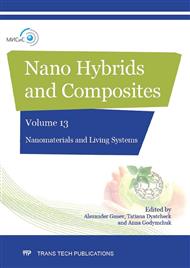p.268
p.279
p.288
p.294
p.301
p.309
p.316
p.323
p.330
PBPK-Model Biodistribution of Gold and Silver Nanoparticles in the Body of Laboratory Animals and Humans at Different Ways of Income
Abstract:
For needs of the modern science, prediction of nanoparticles (NPs) biodistribution is necessary to avoid the disastrous consequences of its uncontrolled usage. For these purposes we have created the mathematical model of NPs’ biokinetics which can predict how much NPs would be in different organs in laboratory animals’ or human’s organism after different ways and regimes of injections. It is based on PBPK-modelling conception where the blood is the main transport of NPs and organs or tissues are proposed as compartment of NPs’ accumulation. The extrapolation from experimental data for laboratory animals to the human organism is implemented by the method of biological similarity. The special algorithm has been created to find the biokinetic constants, which allows to recreate experimental data, and it is based on the method of successive approximation by the criterion of maximum plausibility.The model is released as a computer code on the MATLAB language. There are evaluations of the model’s parameters for two experiments: for single intragastric injection in rat solutions with 35 nm silver NPs and with 8 nm gold NPs. The result of calculations is represented as graph for some organs (liver, kidney and spleen) and it could be considered as acceptable in recreation experimental data. There is also results of calculation for human organism that are got from biokinetic constants by the mechanism of extrapolation. The proposed model can be adapted for others types of metal NPs.
Info:
Periodical:
Pages:
301-305
Citation:
Online since:
January 2017
Authors:
Keywords:
Price:
Сopyright:
© 2017 Trans Tech Publications Ltd. All Rights Reserved
Share:
Citation:


